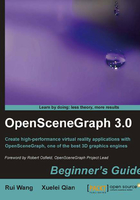
What this book covers
Chapter 1, The Journey into OpenSceneGraph introduces the history, structure and features of OpenSceneGraph (OSG), and introduces the general concept of scene graph.
Chapter 2, Compilation and Installation of OpenSceneGraph guides readers through compiling, installing and configuring an OSG development environment, either by using the prebuilt binaries or building an environment wholly from the source code.
Chapter 3, Creating Your First OSG Program shows how to code an OSG-based application, highlighting the utilization of smart pointers, notifying system, object instances and data variances.
Chapter 4, Building Geometry Models explains how to create a geometry entity simply with vertices and the drawing primitives defined within OSG.
Chapter 5, Managing Scene Graph is all about the implementation of a typical scene graph using OSG, and shows the usages of the various types of scene graph nodes with special focus on some commonly-used node types.
Chapter 6, Creating Realistic Rendering Effects introduces some basic knowledge about OSG implementation of rendering states, texture mapping, shaders, and the render-to-texture technique.
Chapter 7, Viewing the World shows the means by which developers can encapsulate the cameras, manipulators, and stereo supports, and have them work together.
Chapter 8, Animating Scene Objects shows OSG's capability of creating animated graphic presentations by using the built-in animation library, and showcases the implementations of path animations, vertex-level animations, state and texture animations, and character animations that a 3D application can use.
Chapter 9, Interacting with Outside Elements focuses on the implementation of human computer interaction using OSG, including input device handling and GUI toolkit integration.
Chapter 10, Saving and Loading Files explains in detail the working mechanism of reading and writing scene data, and gives tips for creating user-customized I/O plugins.
Chapter 11, Developing Visual Components covers a wide range of advanced scene graph components, including billboards, texts, height mapped terrains, shadows, and volume rendering.
Chapter 12, Improving Rendering Efficiency introduces the techniques necessary for building a fast real time rendering system. It helps users to load, organize, and render massive datasets in a very efficient manner.